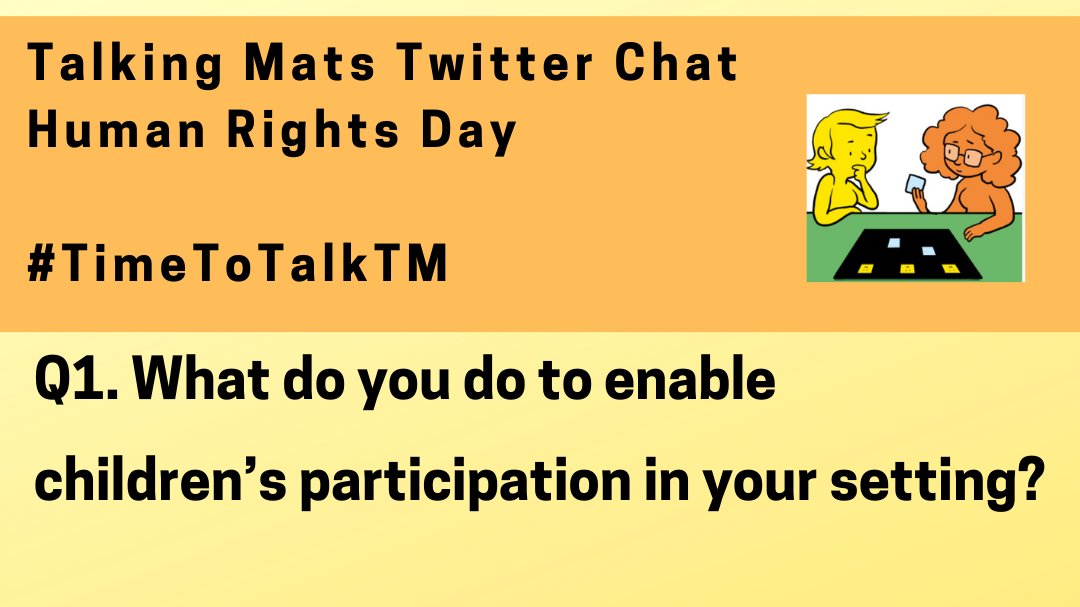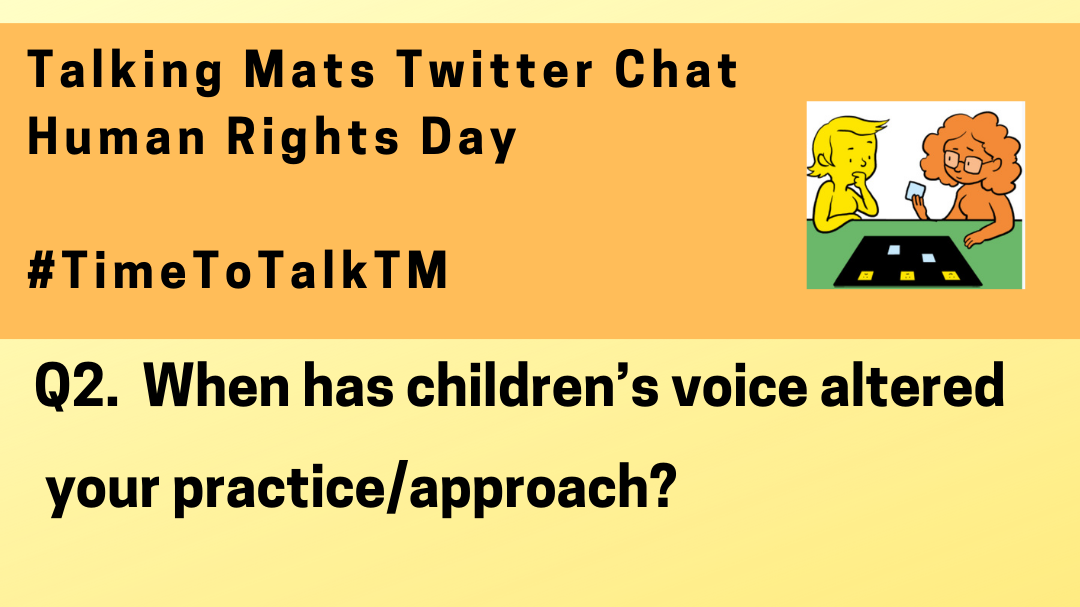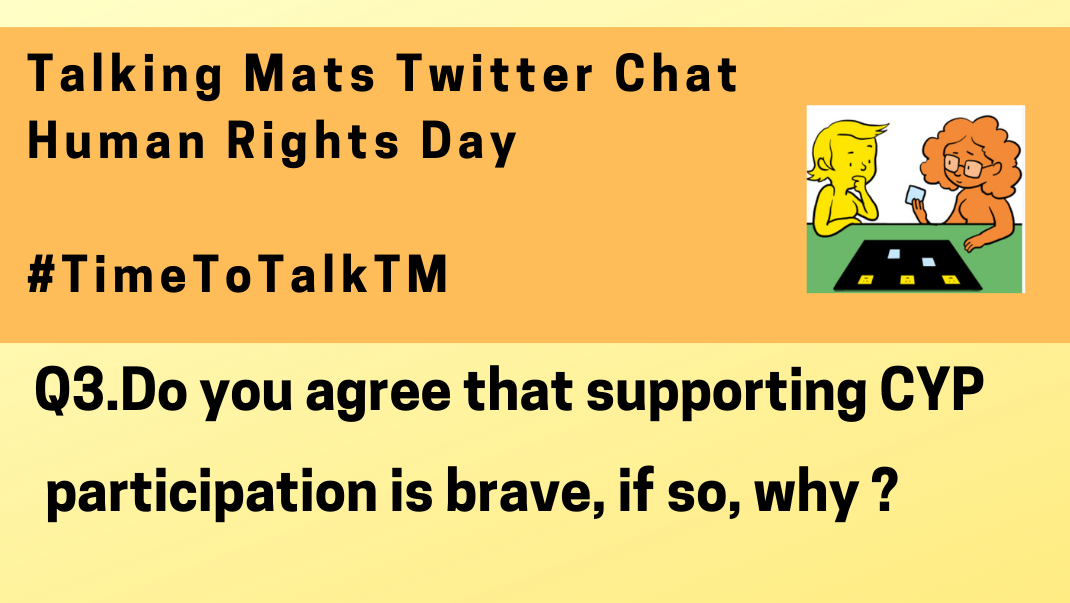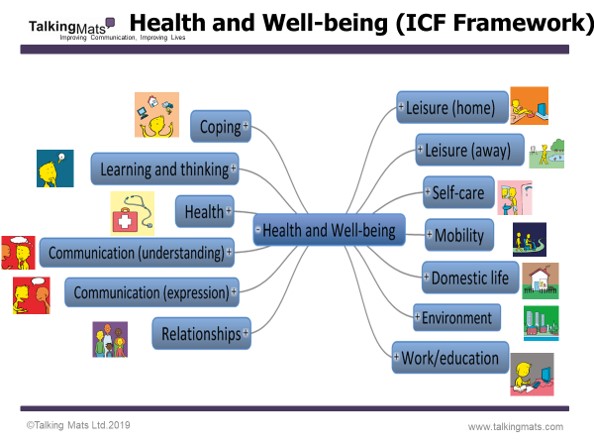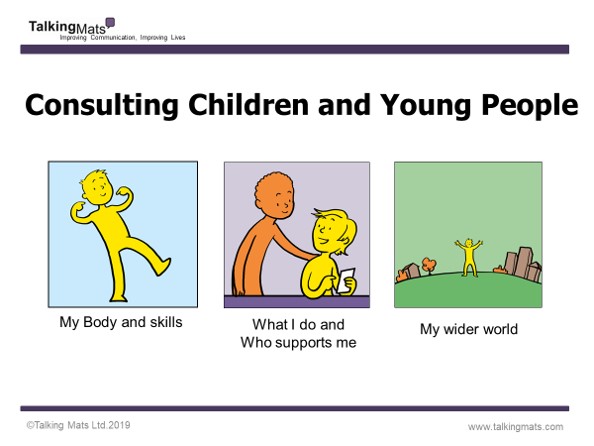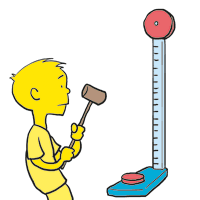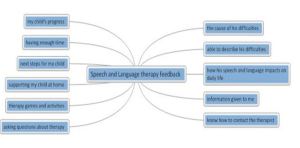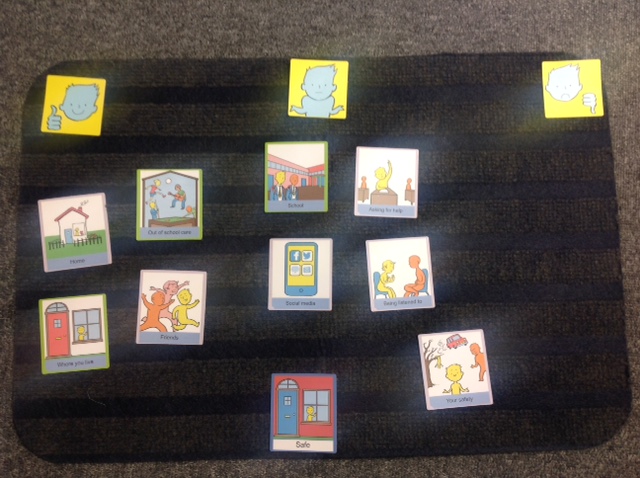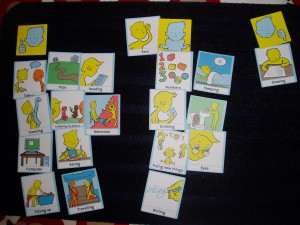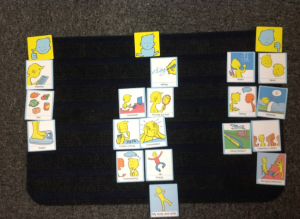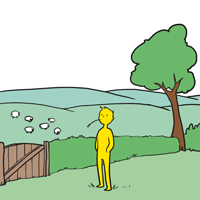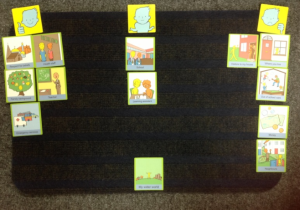We are looking forward to our second Talking Mats Twitter chat on Thursday 10/12/20 7.30 – 8.30pm.
Join us to discuss and celebrate our new report ‘Can Scotland Be Brave’, which has a specific focus on children and young people’s participation. Find out more about the report here https://www.talkingmats.com/new-report-to-launch-10th-dec/
The report will be launched by the Scottish Government on the same day, to coincide with Human Rights Day 2020.
Here are the questions we will be asking:
Grab a cuppa – or better still, a mulled wine and mince pie! – and join us to share experiences and ideas.
Remember to use the hashtag #TimeToTalkTM on all your posts!
In the first of two blogs, we talk about how using Talking Mats Resources can help people have better conversations.
Talking Mats provides a visual framework to help people express their views and feelings, using a selection of communication symbols that cover a variety of topics. Talking Mats resources are used by many professionals across a wide range of health, social care, residential, and education settings. Most of our resources are available in both low-tech, and digital, formats. In this first blog we focus on the resource bundles which are available to purchase with our Foundation Training course.
Our resources are available to buy through our website (https://www.talkingmats.com/shop/) however we do strongly recommend completion of one of our Foundation courses (https://www.talkingmats.com/training/foundation-training/) to get the most benefit from Talking Mats – and to use it to its full potential. If you add a Health and Wellbeing, Consulting Children & Young People, or Social Care resource pack bundle to your training you only end up paying £65 for the training day itself which is a great deal!
Resource Bundles available to purchase with Training
Health and Wellbeing Bundle:
These packs are based on the ‘activities and participation’ domains from the WHO ICF framework and includes 9 topics which are relevant to people, regardless of their health, disability or where they live around the world. We have translated these into more ‘user-friendly’ language and have generated symbols to represent each topic.
In addition to the 9 topics from the Activity and Participation domains, we have also included Environment and Health, which are important topics within the ICF framework and in people’s lives.
Consulting Children and Young People Bundle:
These packs are based on ‘Getting It Right For Every Child’ (GIRFEC), a Scottish framework for everyone to use when working with children and young people. There are three broad topics which are relevant to any child or young person’s life. This resource can also be used with SEND reforms in England. There are different packs for each developmental stage: Early years (ages 3 to 7); Primary (ages 7 to 12) and secondary (age 13 upwards).
Best Value Bundle: This option includes the Health and Wellbeing and Consulting Children and Young People bundles above, as well as our Social Care resource packs, providing a complete set of resources to support communication on a comprehensive range of topics for children and adults.
If you’d like to book a place on one of our Foundation Courses and would like to know more about our bundle options, get in touch with us at info@talkingmats.com
Find out more about our Foundation Training course here: https://www.talkingmats.com/training/foundation-training/
Castle Hill High School has seen the benefits of using Talking Mats to let pupils have their say and be involved in planning outcomes. Jenna McCammon, Speech and Language Therapist & Rebecca Highton, Speech and Language Therapy Assistant, Stockport NHS Foundation Trust explain how they are using Talking Mats at Castle Hill High School.
Talking Mats has been beneficial in supporting young people with communication difficulties in school.
A Talking Mats approach has been used to support a pupil who presents with selective mutism. He started refusing to engage in lessons and activities, so school wanted to find out what he enjoys doing and how best to support him. Talking Mats allowed the speech and language therapy team to find out about his likes and dislikes at school, along with the reasons why he was refusing to engage in certain lessons. The sessions allowed the speech and language therapy assistant to build rapport with the pupil through finding out what he enjoys both in and outside of school, and the pupil communicated verbally during one of the sessions for the first time since his change in behaviour. The speech and language therapy assistant took pictures of the finished piece of work and asked permission from the pupil to share this with school staff. The speech and language therapy assistant was able to feed back the outcomes with staff and with other professionals during TAC meetings. Staff and other professionals would then request if the speech and language therapy assistant could obtain more information from the pupil, when needed, using Talking Mats.
Safeguarding – A possible safeguarding issue was suggested by a pupil during a therapy. The pupil has significant communication difficulties and so the information she was able to provide was very limited. The safeguarding officer in school requested if the speech and language therapy team could try to find out more. This was done us using Talking Mats, which allowed the pupil to share more information about the issue which was then shared with the safeguarding officer.
Motivational Interviewing is a tool used by the speech and language therapy team, both when assessing a new referral and when completing a review assessment in order to set new therapy targets. It is an opportunity for the young person to express their opinion, and can also be used to determine how much insight they have regarding their communication abilities. This is usually done verbally using a 10-point scale, however Talking Mats has been used by the speech and language therapist when assessing pupils with limited verbal ability. This allows these pupils to voice their views and have a say in their therapy planning. The findings from the Talking Mats motivational interviews then contribute to writing EHCP Reports for the pupil and are used to inform the decision-making process regarding their therapy goals.
Thanks to Jemma and Rebecca for sending these great examples. Change happens when we give young people a listening space.
Thanks to Karen Wilson, a specialist teacher and one of our accredited trainers, who describes how Talking Mats can help in supporting Looked After Children in having their say.
‘I work as Principal Teacher for children with additional support needs in a mainstream secondary school. In supporting a wide range of children and young people, I am frequently involved in Looked After Children reviews. These reviews can be quite daunting for an adult, as all agencies involved with the young person are represented, along with their carers and their support agencies. I can’t imagine what it must feel like as the child.
Many of these young people find it difficult to express their views, partly because of the circumstances they find themselves in and partly because many of them have communication difficulties linked to their early experiences. I have been struck by how little information is often contained in their Having Your Say form. This should be one of the key ways for young people to express their views and is completed in advance of the review.
I recently used a Talking Mat to help a young person complete her ‘Having Your Say’ form. The young person reported that it was much easier to engage in the process and told me that she had enjoyed doing it. She normally does not like filling in the form. All of those involved in the review expressed surprise and delight at how much more information it was possible to get using a Talking Mat.
I am now working with Talking Mats to explore how this idea can be developed to give more of our Looked After young people a stronger voice in decisions which directly affect them.’
Have a look at the following blogs for further information on theTalking Mats GIRFEC resource and how it is being used
As part of the Right to Speak initiative Talking Mats was funded to develop ‘Promoting Inclusion and Participation’: an online learning resource for staff working with children and young people who use Alternative Augmentative Communication (AAC). We have been delighted to work with NHS Education Scotland on developing this free resource and also have really enjoyed working in partnership with the learning and development consultancy: Forum Interactive.
The complexity of care for children and young people who use Alternative and Augmentative Communication (AAC) is multifaceted. Ensuring that goals are centred on the young person and family’s needs is a constant challenge to practitioners. There are several resources that focus on developing the technical skills of developing AAC but there is a scarcity of resources that focus on the impact of AAC on the child’s day to day life.
Promoting Inclusion and Participation is based on an earlier project which determined the key indicators of a quality AAC service from the perspective of AAC users and their families.
Promoting Inclusion and Participation uses the following frameworks to help practitioners structure their decision making:
- International Classification of Functioning, Disability and Health – Children and Young People (ICF-CY)
- Janice Light’s Communicative Competencies (2014)
- GIRFEC (Getting It Right For Every Child) wellbeing indicators
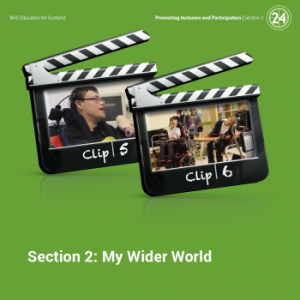
This on-line resource will help practitioners:
- Understand the role that collaboration and involvement play in delivering wellbeing outcomes for children who use AAC.
- Apply a holistic approach and outcomes focused approach to assessment, implementation and review which places the child at the centre.
- Recognise that as the child develops and changes, so the level of different team member’s involvement will ebb and flow.
Download the resource here. It takes a little time to download so be patient !
We would be delighted to receive feedback of how it is being used.
Ref
Light J , Mcnaughton D, Communicative Competence for Individuals who require Augmentative and Alternative Communication: A New Definition for a New Era of Communication? Augmentative and Alternative Communication, 2014; 30(1): 1–18
We are grateful to Nicola King SLT, who describes how she and colleagues use Talking Mats not only to gain feedback from parents about the therapy process, but also about the parent’s understanding of the child’s diagnosis and its impact.
The options to start the discussion are included in the mind map below. Click on image to enlarge.
Issues raised by one parent were
1) Information given to me –unsure . The mum went on to say ‘I’m worried/ frightened. I don’t want to ask too much as I’m frightened as to t he answers
2) My child’s progress –unsure. The mum offered ‘I’m inpatient’
Nicola commented –‘These were huge issues and each response gave me a chance to explore what she was thinking and meaning. For the first time this mum offered her fears about ASD and ADHD. She enjoyed the Talking Mats process and after the interaction agreed for the first time to an onward referral which ensured support was in place for her son starting school.
The Talking Mats format was a brilliant way to have that ‘difficult conversation’ ‘
The intention at the core of the Scottish Strategy Getting it Right For Every Child (GIRFEC) is to keep the child at the heart of the planning process. Helping the child to set personal outcomes based on what is important to them, should be the starting point. In practice, this can be difficult as many of the well-being indicators are difficult for children and parents to grasp. A primary headteacher highlighted the limitations, explaining that she was trying to find out about how safe one of her pupils felt. When the pupil asked her to explain what she meant, she replied “Well, do you feel safe in my office or do you think one of the books might fall off the shelf onto your head?”
The Consulting Children and young people resource allows you to reorganise the symbol sets to reflect on each of the specific well being Indicators. If we take the example of safety, we can make the concept more accessible to the child by providing concrete examples. This may include: asking for help if needed, feeling listened to, as well as, safety in specific settings for example at home; in school; with friends or using social media. The CCYP resource helps the interviewer to think about the child’s age and stage of development and uses examples that are meaningful.
The visual framework means that their is a clear record of the shared understanding between the child and the interviewer of the concept of safety.
We are planning to run specialist sessions on using Talking Mats with the SHANARRI indicators in order to ensure that the child’s view is at the heart of the planning process. If you are interested please let us know what would work best for you.
Email us at info@talking mats and tell us if you would prefer a Saturday session, a Twilight session or a half day session and state your preference for morning or afternoon.
I am a parent of a child in Primary one. We are expected to take our child along to the parent / teacher consultation meetings. After our first meeting I felt dissatisfied and no more informed. As a shy primary one, Eilidh gave no verbal feedback in the meeting, I felt I couldn’t voice any real concerns I had in case I knocked Eilidh’s confidence and the teacher was probably in a similar situation. Instead everyone was very nice but I left without any plan of action and no feeling that Eilidh’s teacher knew how she was feeling about her progress at school.
This time, I plan to be more prepared and to make sure Eilidh is properly at the heart of the consultation. I decided this time to use the new ‘Consulting Children and Young People’ pack, and felt the ‘my body and skills’ section was ideal for thinking about the key aspects of school life.
Eilidh engaged immediately with the mat and seemed confident with what the symbols represented. By the end of the mat and after going over it with her and checking if there was anything we had missed, I feel we have a really good starting point for discussion when we attend the meeting on Thursday.
The key points were:
Eilidh is most concerned about her drawing skills. Her face dropped when she saw the card. She perked up a little when she looked at the symbol as she decided she was good at drawing sunshine but not people. On discussion it turned out she really wants to be able to draw clothes on people. We talked about what we could do and decided she could do drawing practice with her dad (who is much better than me!). She was happy with this and has since already drawn a fully clothed person!
She is a bit unsure about numbers, writing and trying new things. These are things to discuss with the teacher but it shows her awareness of where she needs more support. Going to the toilet and drinking water both require her to ask the teacher for permission and she put those in the middle as she doesn’t always like to ask and often comes home with a full water bottle. This is something we can bring up and hopefully the teacher can reassure Eilidh it is fine to ask.
Finally, we were able to finish on a high as we acknowledged that she has really increased her confidence in talking (at school), reading and getting dressed independently. Again it really shows how aware she is of her own abilities and what she has struggled with in the past.
I would really recommend using the pack for this purpose. If I have time before the meeting I plan to use the other symbol sets to explore how she is feeling about the people at school (friends / teachers / support staff). By Morag Place
Eilidh’s Mat

Tina is a 13 year old girl who initially had coped well with the transition to High School but in February had started to refuse to come to school. She was unable to explain what the problem was and when asked about the reason for her absence, would say “ I hate school”.
The “Consulting children and Young people -secondary resource” was used to consult with Tina. She was presented with some of the options from “My body and Skills” to think about how she was feeling. Tina used the top scale Happy(Things are going well and Not happy (things are not going well).
During the Talking Mats interview she opened up about how she felt about travelling to school (she hated going on the school bus and felt embarrassed) She clearly identified the fact that she has specific learning needs as she has difficulty understanding and concentrating in class and often falls behind with her written work. Attending her maths class was particularly difficult and she did her best to avoid going. She also talked about her difficulty with talking to adults and also to her peers. Often she feels excluded in conversations as although she is listening, she doesn’t always understand what they are discussing and doesn’t know what to say. She has a problem with sleeping and feels her mood is low a lot of the time. She also commented that she can feel extremely angry and this has a negative effect on her behaviour. On the positive side, she loves to read and feels happy about her diet and her weight.
Helping Tina to grade her feelings about specific issues helped to identify what needed to be done in the first instance to get her back to school.
Alternative travel arrangements were put in place, extra support provided for her in class and from the learning support base.
She is attending school again and the pupil support team are gathering together the appropriate “team around the child” to explore her difficulties further.
Find out more about how to use Talking Mats by signing up for a training course at Talking Mats.
The communities where children grow up can have a significant impact on the well-being of both children and families. The Consulting Children and Young people pack contains the topic “My Wider World”. This topic allows exploration of the impact of both school and life out of school as well as the support systems available to them. The World Health Organisation reminds us of the importance of gathering environmental information from children. As a child develops the environments of their everyday life are closely connected to home and school and finding out how the child feels will give insight into their independence and activity. Negative environmental factors often have a greater impact on children than on adults. In order to promote a child’s well-being, effort needs to be given to enhancing a child’s physical environment as well as their social or psychological environment.
Daniel is an 11 year old boy with a diagnosis of Asperger’s Syndrome. He completed a Talking Mat to explore the impact of his environment on his condition. He was asked to grade his responses using the top scale Happy (Things are going well) and Not happy (things are not going well).
He immediately commented about how he felt about school (“yeah –it’s okay”) He expressed a strongly negative reaction when asked about where he lived. He was very unhappy about the location of his house as it is in an extremely remote location and he can never have any friends round to play. He never gets visitors to his house apart from an uncle that may drop by. He feels bad that he doesn’t have any neighbours and would love to live somewhere that has got other houses nearby. He has talked to his mum about it but she says, “she can’t take me places – too much petrol” He knows that his mum is worried about money. He also really dislikes “out of school care” as he is rarely allowed to play on the computer. He is happy with his teacher, support from health services and the emergency services.
Daniel was clearly upset about his lack of social integration and contact with his wider community.
Environmental support included supporting the care-givers in the “out of school club” by providing training and advice about Asperger’s Syndrome.
Social work became involved to help to help locate local youth groups and finance.
Find out more about how to use Talking Mats by signing up for a training course at Talking Mats.
 Online training login
Online training login 

